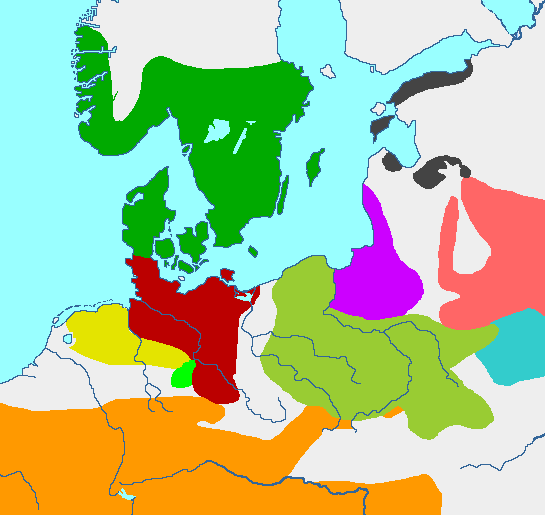@Garrick,
If I2a-Din was Germanic and Gothic, why not equal quantities of R1b-U106 and I1 in the Balkans?
Angela, yes, your question is right in the center.
And question is very complex, as this mattery is very complex.
I will try to see some facts (of course it is simplistic, for detailed discussion we can write scientific monography), with what we can dispose and what we can talk about.
I2 and generally I haplogroup is exciting for studying, the first Homo sapiens in Europe in period 45,000 to 28,000 years ago were I carriers (plus CT, C1a, C1b and F). I2 carriers were in Europe in Paleolithic 26500-19000 ybp, I2 and I1 carriers are practically only true Europeans and autochthonous. This fact is important to know where the carriers of the I2a haplogroup could move in the old days.
I-P37 is Forefather of I-CTS10228. This haplogroup is found in Balkans, Serbia, in Lepen whirl, location Padina, age estimation is 8753-8351 BC. Very important lineage I-M423 is found in Loschbour, today’s Louxembourg, 6000 years BC.
If we try to notice where the predecessors of I-CTS10228 lived there is Middle, Western and Northern Europe and beyond, reaching Western parts of Eastern Europe. It is nothing to do with areas of Near East, Caucasus, Iran, Russia, Finland etc. This fact is very important. I-CTS10228 is formed 5300 years ago and it was somewhere in Middle/Western/Northern Europe. It is barely survived, and for now we don’t know about reasons for bottleneck, but area where it lived is logical.
After bottleneck I-CTS10228 emerged before 300 BC. Where? It can be somewhere in today’s Poland/Southern Poland, Slovakia, Carpatian area and beyond.
Who lived in this time in this areas?
Slavic people no. It is the important fact. If I-CTS10228 didn’t emerge among Slavs it cannot be Slavic marker.
We can try to get knowledge in which tribe I-CTS10228 could emerge.
We can acquire knowledge from Greek and Roman sources.
We can see in the Ptolomy map which (#580).
In Poland, Slovakia and Western Ukraine lived German tribes, on the south Thracians and on the east, Sarmatians, who were Iranian people.
Where we can search Slavs , they are Venede in the Baltic sea.
We will not search nationalistic German and Polish/Russian sources which every culture in Iron age in aforementioned areas and beyond proclaimed as Germanic or Slavic depending on whether author is German or Slavic origin .Therefore we escape this.
In that time in these areas and beyond were Celtic, Sarmatian, Thracian etc. tribes and some cultures were mixed.
Some scholars some of cultures in the areas of present days Poland, Slovakia, Western Ukraine, Carpatian mounntains in Iron age claim even as Illyrian.
For one of significant culture in that time, which covered big part of Poland and beyond, even reached Moldavia, Pomeranian culture, scientists are sure it is not Slavic, but they are not sure if it is Germanic or no. But tribe Bastarnae is good candidate for this culture, and this is German tribe:
https://en.wikipedia.org/wiki/Pomeranian_culture
In the picture: Pomeranian culture (oliva green)
And Zarubintsy culture since 300 BC was not Slavic:
https://en.wikipedia.org/wiki/Zarubintsy_culture
If we can enter in historical Roman and Greek sources, we can see that Slavic people were connected to the territory from river Dneister in today’s Central Ukraine to Baltic sea. Maybe Milodrag culture, located in area the rivers Dnieper and Pripyat, north from Kiev, can be Slavic culture, although it is not proven:
https://en.wikipedia.org/wiki/Milograd_culture
But culture is very far of area where I-CTS10228 emerged.
What is saffer terrain, to see which tribes lived in the aforementioned area approximately in 300 BC.
Several German tribes are candidates:
Lugii: they lived in today’s Silesia, Greater Poland, Mazovia and Little Poland.
https://en.wikipedia.org/wiki/Lugii
Buri: they lived between Southern Poland, Czech and Northern Carpatian. Not to be confused with Thracian Burs.
https://en.wikipedia.org/wiki/Buri_tribe
Lugii and Buri were mentioned by Ptolomy as one tribe Lugoi Buroi.
Scirii: they lived in Northern Poland and they moved about 200 BC to the south about 230 BC. Later they lived in Carpatian mountains and Black sea. They mixed with Bastarnae.
https://en.wikipedia.org/wiki/Scirii
Bastarnae: Their homeland is probably Pomerania (today Poland) or Southern Poland and Western Ukraine. They migrated and lived since 200 BC in region of Carpatian mountains, to the river Dnieper in Ukraine and were connected with Thracians on the south and Sarmatians in the East. They came to the present days Moldavia and Romanian Danube Delta. They reached Balkans more times in Thracian land.
If we see time and geography the best candidate for first I-CTS10228 carriers after bottleneck are Bastarnae and maybe Scirii.
Therefore neither Goths not Gepids are candidates, they came later from the north, but it can be possible that these tribes could pick up somewhere this haplogroup in their movements.
Bastarnae mixed with Thracians and Sarmatians. Thracians brought this haplogroup to the Balkans and Sarmatians probably transfered to the Slavs.
There is no doubt that I-CTS10228 will be found in the Balkans ,in period 0-5th century AD (maybe even earlier) what is significantly before arrival of Slavs.


